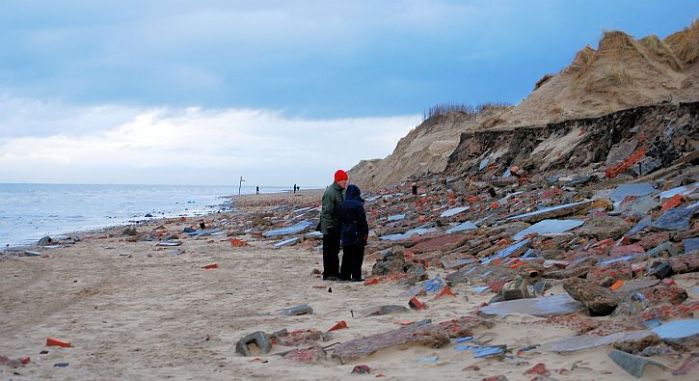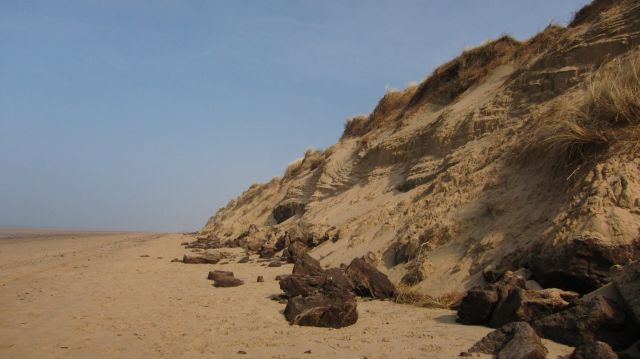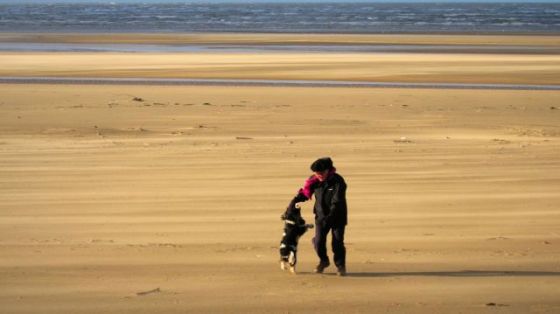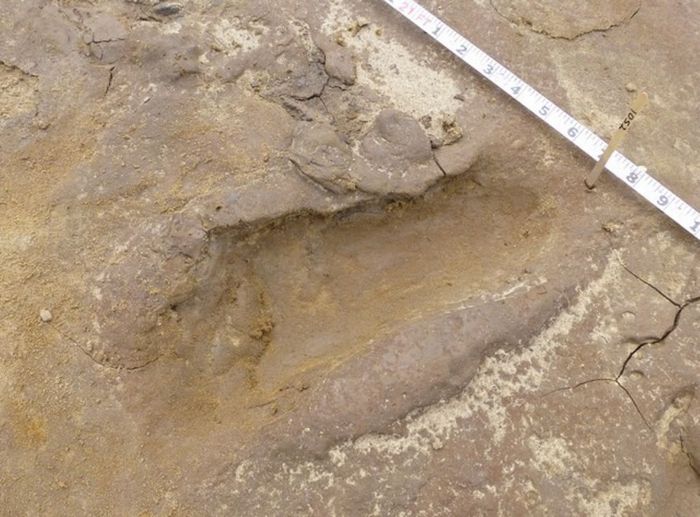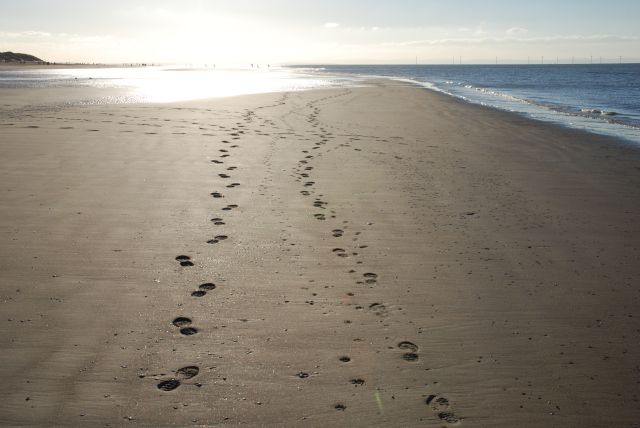
Regular readers of these posts will now that one of our favourite places is the coastline north of Liverpool, stretching from Formby Point up to Ainsdale, with many walks along strand and through dunes in a place that feels so wild and so distant, yet within sight of the city skyline. Jean Sprackland once walked here for twenty years, and in Strands: A Year of Discoveries on the Beach, prompted by an impending move to London, she gathered a series of meditations on the things she encountered along the shore in her last year here. It’s a book I ought to have read sooner; now I’ve finally got round to it.
Jean Sprackland is best-known as a poet which led me to expect something a little more lyrical than this beach-combing journal, its entries organised around the seasons and each one triggered by her encounter with an item – living or inanimate – washed there by the tide. In this it shares some similarities with Edgelands byPaul Farley and Michael Symmons Roberts or Kathleen Jamie’s Findings and Sightlines. But it doesn’t have the former’s constant referencing of poetic or artistic responses to the habitat, nor Jamie’s personal evidence-gathering and interviews. Instead, in parts at least, there’s a sense of material gathered in from expeditious googling.
I don’t mean that to be over-critical. Indeed, I enjoyed the way Sprackland might launch off at a tangent, triggered by some flotsam, plant or animal discovered while she walked the tide-line, meanderings that sometimes end up a long way from Ainsdale beach. One of the best chapters, entitled ‘The Albatross and the Toothbrush’ is of this nature, beginning with an old Marathon wrapper catching the author’s eye one morning. Noting that Cadburys changed the name of the Marathon bar to to Snickers in 1990, Sprackland realises that the Marathon wrapper must be at least 20 years old- and is still in good condition despite being buried in the sand or floating at sea all that time.
Flicking through her old copy of The Arrow Seaside Companion, published in 1956, Sprackland notes that its author’s catalogue of ‘useful finds’ he had made on the beach in the 1940s and 1950s contains nothing made of plastic. In contrast, in merely one hour, Sprackland finds 311 plastic items, ranging from bottles and bin bags to disposable cigarette lighters and cotton bud sticks.
She goes on to discuss the ubiquitousness of waste in the oceans and the phenomenon of the North Pacific Gyre:
The Gyre has become home to something known as the Great Pacific Garbage Patch, a gigantic stew of suspended plastic and other human debris. [… ] Estimates put the garbage patch at a hundred million tons, and it is aid by some observers to cover an area twice the size of Texas.
Seabirds are particularly at risk once sea-borne plastic waste enters the food chain, and this reminds Sprackland of Coleridge’s ‘Ancient Mariner’ which can be read as a prophecy, or warning, of the consequences of interfering with the natural order. She tells how, in the Pacific, albatrosses have been dying recently in great numbers. When researchers dissect the corpses and examine the stomach contents they find a shocking variety of plastic objects: toothbrushes, cigarette lighters, Lego bricks and bottle tops. She writes:
It’s the familiarity – the domesticity – of these small, disposable objects which breaks the heart.
That word ‘disposable’ has, as Sprackland observes, a hollow ring. Since the 1950s it’s estimated that one billion tons of plastic have been discarded – and most of it will take hundreds, even thousands of years to degrade. We talk, she says, about ‘getting rid’ of things we no longer want, but because plastic is so durable we will never be rid of it. A great deal of it ends up in the sea, and, as anyone who walks a seashore these days will understand, ‘the sea always brings them back’:
It brings them back, and takes them away, and brings them back again. My most sobering moment on this beach was not one spent picking through trash in the strandline as I did today. It was a glorious day in March, after the high tides of the spring equinox. The sea had come in much further than usual, right into the dunes, and washed the beach clean and shining. The mass of accumulated debris I’d seen there the week before was gone. The sea had swallowed it again. I understood then that for the bottle and the laundry basket, the clothes peg and the doll, the petrol can and the chocolate wrapper, this is a journey with no end.

This account of a year’s finds on Ainsdale Sands is a kind of extended farewell to a place Sprackland has left behind. Strands was written during 2010, her last full year at Ainsdale, and catalogues the various finds she makes on the beach. In a piece written for the London Review of Books she explained
I’ve been walking on the shore at Ainsdale and Formby, on the north-west coast of England, for 20 years. It’s hardly the prettiest or the most unspoilt beach: its sands are not the most golden, and there are no rockpools or hidden coves. It’s not dramatic either: no pounding surf or rugged cliffs. Stand here, on a reasonably bright day, and you can see the offshore wind farm in the Mersey estuary. Turn the other way, and there are the familiar Blackpool landmarks: the tower, the rollercoaster. But in really clear weather you can see the southern fells, the Clwydian hills, the pale but unmistakable shape of Snowdon.

‘Strand’ is a word that can carry different meanings. It can be a synonym for the beach, can evoke the idea of stranded things and whole objects reduced to ‘strands’ – mere strings and ribbons – and strands can also be lines of connected thought or enquiry. In an interview with The Scotsman, Jean Sprackland said:
Strands came partly out of a particular sort of paradox. Having lived on that stretch of coast for so long I felt that I knew it extremely well. I was going back there day after day, month after month, and I felt that I knew it intimately, and yet at the same time it was unknowable. Perhaps that’s why I found it such an exciting place – it was something to do with knowing it well and yet knowing that there is an unlimited amount to be learned about it, too. Every time I walked there I would see something I didn’t understand or find something I didn’t recognise or have some kind of new experience. Every single time.
The things that Sprackland finds on the beach – the strandings, on the strand, carrying with them their strands of stories – are enormously varied. For instance: the remains of the Star of Hope, wrecked on Mad Wharf in 1883 and usually just visible as a few wooden stumps, which appears out of the sand at certain tides.
When I say that this place is changeable, this is one of the things I mean. The tides and currents conspire to move and reshape the sand, and in the intertidal zone a skeletal old ship emerges. The rest of the time it’s buried and invisible; people and dogs walk and run over it with no idea that it’s there. Then, without warning, it rises to the surface. It takes the air for a few weeks, before subsiding into the sand again.
Sprackland revels in such chance encounters, the ‘cargo of mysteries’ delivered by each tide:
Like so many of our happiest meetings, they are coincidental. You happen to be walking along the right part of the shore, just as something is delivered there by the tide. The two of you are on separate journeys. You come from one direction, it comes from another, and your paths intersect.

The wreck of the Star of Hope on Ainsdale beach (photo: Liverpool Echo)
The aforementioned human junk – the ubiquitous plastic objects, sweet wrappers and crisp packets – form only part of Sprackland’s catalogue of finds. As the seasons change, so do the items discovered on the shoreline. In spring there are leathery mermaids’ purses (the egg cases of dogfish, ray and skate), sea gooseberries like pearly marbles and the ‘scribble of wormcasts’ along the water’s edge. Summer brings a green flourish of samphire or poor man’s asparagus, grey seals and, occasionally, disconcerting swarms of ladybirds. After autumn storms there is driftwood, starfish are flung to their deaths by high tides, and she finds sea potatoes (the fragile shells of sea urchins). Then winter comes, with squally days and ‘dangerous skies’, and the shocking sight of a dead herring gull spread out like ‘an open book, ‘very much undone … as if someone has unpicked the stitches which held it together’.

In the coldest winters (such as, memorably, December 2010), ice along the tide-line. Here, Sprackland remarks: ‘It’s always a thrill to see ice on the beach’. But the phenomenon was captured more memorably in her poem ‘Ice on the Beach’:
One single sheet of sprung light.
Touched here with the toe of your boot
it hurts in a distant part.
Dream stuff, with its own internal acoustic.
Striking it with a stick raises
a shocked note, a white bruise under the skin –
the physiology of ice on sand
is strange, we have not mapped it.
The sea can only scorch the edge.
This whole bay is locked
under a lid of referred pain.
At one end, a tanker
nudges out of the rivermouth.
In its wash, the ice shelf
barely shivers.
But thirty miles south,
in another town, it creaks
under the pier, where someone kneels
staring down like a god
through a damaged sky, onto a wilderness
of ridges and blue shadows.

Ice on Formby beach: New Year’s Eve 2010
Among the finds which Sprackland muses upon are sea coal, a message in a bottle, different kinds of seaweed, jellyfish and sea squirts, the strange corpse of a sea mouse, a china teacup and a large lump of compressed tobacco waste, the by-product of cigarette manufacturing in Liverpool at places like the St Bruno pipe tobacco factory in Bootle that began operating in 1896. In 1956, the British Nicotine Company, a division of Imperial Tobacco, werre given permission to dump 22,000 tons of wet tobacco waste on fields behind the dunes. It was spread in layers and left to dry, before being mixed with sand and then buried. Now the waste is eroded at every high tide. We found huge blackened lumps of the stuff exposed along Formby beach after the storm surge of 5 December last year.
Sprackland takes to the internet to identify the china cup, washed up whole, and it turns out to be from an old Cunard liner, surprisingly intact after some 50 years at sea. She visits the Maritime Museum in Liverpool to research the Queen Mary and Queen Elizabeth from which the cup was thrown or fell. We think of the sea as wild and untamed, muses Sprackland, yet the secrets it contains and reveals are very often of our own making: ‘The tideline is an open book in a babble of different languages: an account of what the world desires, and then wishes to be rid of.’
In another passage Sprackland writes:
In their book Edgelands, Paul Farley and Michael Symmons Roberts sing the praises of forgotten and overlooked places outside our towns and cities, spaces which are neither urban nor rural. I could make a case for the beach as a kind of edgeland. It’s a literal edge, of course. It’s liminal but not unspoilt. There’s litter, there’s joy-riding; it’s still possible to see the historical evidence of what little industrial activity has been possible here – sand extraction, tipping. But it’s essentially intractable land, unreliable and unproductive, so its heart remains wild.

If you were wondering about the sea mouse that popped up earlier, it’s not a mammal at all, but a scaleworm that burrows its way beneath the sand, eating carrion, detritus and microscopic animals. It’s oval, about four inches long and looks furry – hence the name. In one of the surprisingly few references to poetry in Strands, Sprackland quotes from Amy Clampitt’s poem, ‘Sea Mouse’:
The orphanage of possibility
has had to be expanded to
admit the sea mouse. No one
had asked for such a thing,
or prophesied its advent,
sheltering under ruching
edges of sea lettuce—
a wet thing but pettable
as, seen in the distance,
the tops of copses,
sun-honeyed, needle-pelted
pine trees, bearded barley,
or anything newborn not bald
but furred. No rodent this
scabrous, this unlooked-for
foundling, no catnip plaything
for a cat to worry, not even
an echinoderm, the creature
seems to be a worm. Silk-spiny,
baby-mummy-swaddled, it’s
at home where every corridor
is mop-and-bucket scrubbed
and aired from wall to wall
twice daily by the inde-
fatigable tidal head nurse.
Amy Clampitt, familiar with the shore on the other side of the Atlantic in Maine, also wrote ‘Beach Glass’, a poem that celebrates finds along the shore and which might serve as counterpoint to Sprackland’s journal which also records found objects, whether natural or manufactured:
While you walk the water’s edge,
turning over concepts
I can’t envision, the honking buoy
serves notice that at any time
the wind may change,
the reef-bell clatters its treble monotone, deaf as Cassandra
to any note but warning. The ocean,
cumbered by no business more urgent
than keeping open old accounts
that never balanced,
goes on shuffling its millenniums
of quartz, granite, and basalt.
It behaves
toward the permutations of novelty-
driftwood and shipwreck, last night’s
beer cans, spilt oil, the coughed-up
residue of plastic- with random impartiality,
playing catch or tag
or touch-last like a terrier,
turning the same thing over and over,
over and over. For the ocean, nothing
is beneath consideration.
The houses
of so many mussels and periwinkles
have been abandoned here, it’s hopeless
to know which to salvage. Instead
I keep a lookout for beach glass –
amber of Budweiser, chrysoprase
of Almadén and Gallo, lapis
by way of (no getting around it,
I’m afraid) Phillips’
Milk of Magnesia, with now and then a rare
translucent turquoise or blurred amethyst
of no known origin.
The process
goes on forever: they came from sand,
they go back to gravel,
along with treasuries
of Murano, the buttressed
astonishments of Chartres,
which even now are readying
for being turned over and over as gravely
and gradually as an intellect
engaged in the hazardous
redefinition of structures
no one has yet looked at.

Elsewhere, Sprackland meditates upon the prehistoric human footprints that are sometimes uncovered along the shore here, the foot marks pressed into the sediment thousands of years ago and briefly revealed before being washed away beneath the waves:
These beach footprints are graphic physical messages from the past. Where a human being has placed a hand or a foot, and made a mark, there’s a shortcut of recognition, a spark leaping across millenia. What connects us is that we share the same kind of body.
She ends with thoughts on time travel provoked by discovering these footprints:
Like Crusoe, I’ve found proof that I’m not alone. It’s not just space we share, but time too. When I unlace my boots and step barefoot onto the freezing mud, I experience a tangible sense of connection with the past. There were other lives lived out in this place, and the intertidal zone is the place where their mysteries are kept.
Seven thousand winters have passed since these footprints were laid down, preserved and buried. […] There was no wheel, and no writing yet. Stonehenge was still a couple of thousand years off. But in Mesopotamia, wheat and flax were being farmed. […] For a second I see that five thousand years is not some abstract concept, but simple and actual and not unimaginably long.
And now at last they have come to the surface again: the marks my analogues made, as they gathered shellfish and hunted for food, and those made by their children as they ran about and played in the mud. I can trace a footprint with my fingers, put my own bare foot inside it. It’s the nearest I can get to time travel.

All the photos here (apart from the one of the wreck of the Star of Hope) were taken by me at various times on Formby beach, a little to the south of Jean Sprackland’s old stamping ground.
See also
53.410777
-2.977838





















